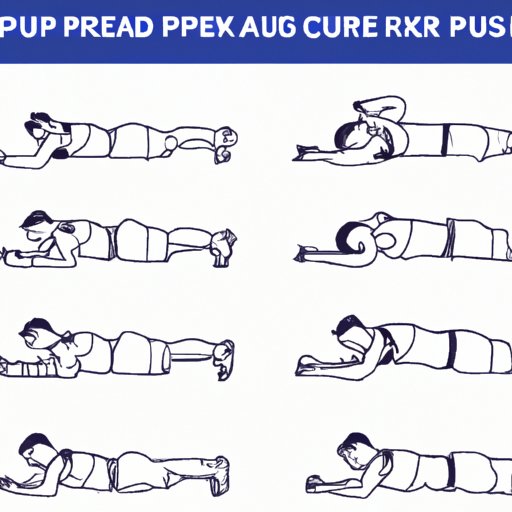Introduction
Push ups are a great way to build strength and increase overall fitness. They’re simple, require no equipment, and can be done almost anywhere. Plus, they’re one of the most effective exercises for strengthening the chest, arms, shoulders, core, and back. But when it comes to figuring out how many push ups you should be able to do, it’s not always so straightforward.
This article will provide an overview of the benefits of doing push ups, explain how to calculate your push up capacity, and offer tips for mastering various push up variations. Read on to learn more about setting and achieving your push up goals.
How Many Push Ups Should You Aim For?
When it comes to setting push up goals, there is no one-size-fits-all answer. The number of push ups you should aim for depends on factors like your age, gender, and current level of fitness. According to a study published in the International Journal of Exercise Science, men aged 18 to 25 should be able to perform 20 to 30 push ups in one set, while women in the same age group should be able to do 10 to 15 push ups in one set.
It’s important to understand your current level of fitness before setting a goal. If you’re just starting out with push ups, it’s best to start with a manageable number and work your way up from there. Start by doing as many push ups as you can in one set without sacrificing form or technique. This will give you a baseline from which to measure your progress.
A Guide to Mastering Push Ups
In order to properly execute a push up, there are a few key points to keep in mind. First, make sure that your hands are shoulder-width apart and your feet are hip-width apart. Keep your body in a straight line from head to toe and avoid arching your back. As you lower your body towards the ground, tuck your elbows in towards your sides and keep your core engaged. When you reach the bottom of the push up, press into the ground and push yourself back up to the starting position.
Once you have mastered the proper form and technique, you can begin to progressively increase your repetitions. Start by adding one repetition per day until you reach your desired goal. Make sure to take rest days in between workouts and focus on good form to ensure that you are getting the most out of each rep.
Staying motivated is key to achieving any fitness goal. Whether it’s a personal challenge or a competition with friends, having something to work towards can help keep you on track. You can also mix up your routine by trying different variations of the classic push up, such as the wide arm, diamond, or decline push up.

Calculating Your Push Up Capacity
If you’re looking to set a specific number of push ups as your goal, a good place to start is by estimating your maximum number of push ups. To do this, subtract your age from 220 and multiply the result by 0.6. For example, if you are 30 years old, your estimated maximum number of push ups would be 132 (220 – 30 = 190 x 0.6 = 114).
Another way to gauge your progress is to track your number of push ups over time. You can do this by tracking the number of push ups you can do in one set and the total number of sets you can complete. This will give you a better idea of how close you are to reaching your goal.

Strengthening Your Upper Body with Push Ups
In addition to increasing your overall push up capacity, there are a number of push up variations that can help you strengthen and tone your upper body. Different variations target different muscle groups, so it’s important to choose the ones that are right for you.
Wide arm push ups, for example, target the chest muscles and require you to spread your arms out wider than the standard push up. Diamond push ups, on the other hand, target the triceps and require you to bring your hands together in a diamond shape. Decline push ups are another variation that target the chest and require you to elevate your feet above your head. Finally, incline push ups target the shoulders and require you to elevate your hands above your head.
The recommended number of push ups for each variation varies depending on your level of fitness. Beginners should start with 3 sets of 8 to 10 repetitions for each variation and gradually increase the number of repetitions as their strength and endurance improve.
Conclusion
Push ups are a great way to build strength and increase overall fitness. They can help you strengthen your chest, arms, shoulders, core, and back, and can be done almost anywhere with no equipment. The number of push ups you should aim for depends on factors like your age, gender, and current level of fitness, but understanding your current level of fitness and mastering proper form and technique are key to achieving your goals.
In addition to increasing your overall push up capacity, there are a number of push up variations that can help you strengthen and tone your upper body. Start with 3 sets of 8 to 10 repetitions for each variation and gradually increase the number of repetitions as your strength and endurance improve. With dedication and consistency, you can reach your push up goals in no time.
(Note: Is this article not meeting your expectations? Do you have knowledge or insights to share? Unlock new opportunities and expand your reach by joining our authors team. Click Registration to join us and share your expertise with our readers.)
